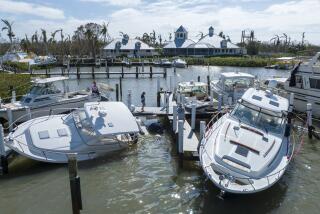Fast-Growing Naples Is the ‘Last Frontier’ of the Good Life in Florida
NAPLES, Fla. — Fed up with harsh winters and a bleak economy in East Lansing, Mich., Jane Fitzpatrick and her husband dreamed of life by the sea in sunny South Florida.
They considered the teeming Atlantic “Gold Coast” first, but there was culture shock in Latinized Miami and in the nearly solid line of high-rises on the beaches stretching to West Palm Beach. They turned to Florida’s southern Gulf Coast and found too many cars, too many people and too many shopping centers in cities such as Sarasota and Fort Myers.
Then they came to Naples, and found home.
“It had a much prettier look,” Jane Fitzpatrick, 35, recalls 2 1/2 years later. “The people were friendly and it had a quaint feeling. And it looked like it had a chance. The damage hadn’t been done yet.”
Florida, the nation’s fastest-growing state over the last three decades, surpassed Pennsylvania this year to become the fourth most-populous state. And Naples, a last frontier of year-round sun and sand, is a microcosm of that frantic growth. In Naples, the rush is on.
‘A Hot Town’
“This is a hot town,” said John Mueller, whose Mueller Co. is one of the city’s leading real estate firms. “Everybody wants to get in on it. The real estate prices are zooming, especially on the beachfront lots. Once they’re gone, there will be no more.”
A palm-fringed waterfront lot in exclusive Port Royal worth $42,500 in 1973 is going for $475,000 today. One dazzling home sold for $1.1 million, and an offer of $2 million was received before closing was completed, Mueller said.
Mueller, whose Minnesota family years ago sold the egg noodle company that still bears its name, moved here with his wife in 1972. It seemed a perfect place to raise their two daughters.
“The economy was strong, but there wasn’t the pressure,” Mueller said. “It was a nice, sleepy town.”
Naples is wide awake now.
The population in the Naples area, fewer than 6,000 people just three decades ago, jumped from 85,971 in 1980 to about 125,000 at the end of 1986. A Dun & Bradstreet report released in March called Naples the fastest-growing metropolitan area in the nation.
That growth also has brought snarled traffic, one-hour waits at the best restaurants and a flock of entrepreneurs.
There are dozens of banks, where as recently as 1960 the only bank in Collier County was in tiny Everglades City.
Now, Mueller said, “The financial competition is feverish; the stockbrokers, the realtors, the lawyers are coming in to try to make their million.”
“You can’t always have your Utopia to yourself. Growth is inevitable. If it has to come, let’s do it right.”
Jane Fitzpatrick is Collier County’s growth management coordinator, a position just recently created. “We can’t stop growth,” she said, “but we can control growth.”
Her job stems from landmark state legislation passed in 1985-86 as Florida’s politicians tried to bridle growth in a state that has swelled in population from 5 million in 1960 and is expected to have 20 million residents by the year 2000. Every Florida county must submit plans in 1989 detailing how every inch of their land will be used.
Extended Sales Tax
Florida, which has no state income tax, last April extended its 5% sales tax to services including advertising, lawyers’ fees and construction. The controversial expansion of the sales tax is expected to generate $761 million this fiscal year.
However, a special statewide commission reported earlier this year that with an average of 893 people moving to Florida each day, it will cost $52.9 billion to pay for growth-related needs such as new roads and new schools over the next 10 years.
“It staggers the mind,” said Tom Pelham, head of the state’s Department of Community Affairs in Tallahassee.
A special concern in the state is the large number of elderly people. There were only 123,000 Americans over age 85 at the turn of the century; today, there are 173,000 over 85 in Florida alone.
With longer lives meaning more years of retirement, the sunny peninsula has more than 2 million people over age 65, a population segment that has doubled in the last decade and a half.
Projections released in July by the University of Florida Bureau of Economic and Business Research indicate there will be 364,000 people over age 85 by the year 2000.
“What these numbers tell me is there’s going to be a much heavier demand put on both private and public services over the next decade, especially in the area of health care,” said John C. Henretta, a researcher with the university’s Center for Gerontological Studies.
The continuing stream of people is also putting intense pressure on the environment.
An increasingly vocal and well-organized environmental lobby is insisting that more be done to protect the many sensitive wetlands.
In Naples, growth has brought the need for more and better-planned roads, more schools for a student population projected to rise from 17,000 now to 28,000 within a decade, expanded sewage disposal systems and housing affordable for the thousands of employees needed in the growing tourism and service industries.
The average condominium sale was about $126,000 last year, while the average single-family home sale was $146,000.
Even if all new construction halted tomorrow, the apartments, condominiums and subdivisions already under way could add 200,000 to 300,000 more people to Collier County when completed.
Despite the frenetic pace of development, there’s little panic.
The air is clean, the crime rate has grown more slowly than the population and, although traffic is congested, it’s not nearly as bad as in other South Florida cities.
“Realistically, we can double the amount of people with no major problems,” said Arnold Glass, a retired Navy intelligence officer and a county commissioner. “We’ve seen the mistakes that have been made elsewhere--the crowds, the traffic, the concrete canyons. We know what we don’t want. We’re not going to let it happen here.”
Keeping the city different has been the history of Naples.
The early settlers, such as Louisville Courier-Journal publisher Walter Haldeman, who bought 8,700 acres in 1875 for $1.50 each, were dedicated to creating and preserving a resort enclave. Rose Cleveland, the sister of President Grover Cleveland and his social First Lady until he became the first President married in the White House in 1886, was another early resident.
Until 1920, virtually the only way to get to Naples was by a 49-passenger steamer ferry. Then, construction began on the Tamiami Trail (U.S. 41), which crosses the Everglades to Miami. The first rail link was completed in 1926.
More to Read
Inside the business of entertainment
The Wide Shot brings you news, analysis and insights on everything from streaming wars to production — and what it all means for the future.
You may occasionally receive promotional content from the Los Angeles Times.










